War on Terror Drives Dynamic Military Innovations
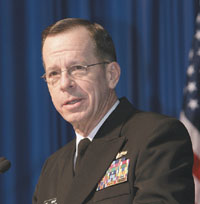 |
| Adm. Michael G. Mullen, USN, chief of naval operations, gives the Keynote Address at West 2006 in San Diego. |
The changes wrought on the
Many of these causes and effects were discussed at West 2006, the annual conference and exposition sponsored by AFCEA International and the U.S. Naval Institute. Titled “Service Roles and Structures: What’s Right for the Way Ahead,” the three-day conference held January 10-12 in San Diego included speakers, panels and courses.
While the conference was rife with substantive discussion, what might have been the event’s most memorable moment came when Adm. Michael G. Mullen, USN, chief of naval operations (CNO), officially announced that DDG-106, the Navy’s next guided missile destroyer, would be named after the late Vice Adm. James B. Stockdale, USN, a highly decorated former prisoner of war in Vietnam and vice-presidential candidate in 1992. Adm. Stockdale’s widow was in attendance for the luncheon announcement, and she shared in receiving the standing ovation after Adm. Mullen announced the honor. “We name our destroyers after heroes,” he told the Keynote Address attendees, “and I can think of no better name for our next guided missile destroyer than the USS Stockdale.”
The rest of the CNO’s address contained additional important announcements of changes to come. He told the audience that he was going to reverse recent changes and stand up a separate N-6 directorate at the three-star level. Not only is the Navy ready for this, he said, now is the time.
Nor was Adm. Mullen shy about the importance of FORCEnet. “FORCEnet is the largest future force multiplier,” he declared. “It must be real,” as opposed to being merely theory, he emphasized.
The point that Adm. Mullen returned to repeatedly was that the Navy’s future must focus on capabilities, not platforms. Most challenges require intelligence and precise action, not mass and movement. While the fleet must encompass both networks and platforms, the Navy should build for capabilities first and the rest will follow.
“We must design the fleet to support the network, and we must design the network to empower the fleet,” Adm. Mullen declared. “And, to empower the fleet, the network must empower the sailor.”
Network-centric capabilities already have led to significant improvements in naval operations. One example the admiral cited is that the time needed for a call for fire has been compressed from 20 minutes to just two minutes.
However, the admiral decried the existing procurement process. “We have spent a lot of time and money competing with each other,” he charged. “We cannot keep doing that.”
The Navy cannot afford every new gadget that comes out either, he stated. When it comes to funding, Adm. Mullen said, “We are at the edge” as budget cuts loom. The Navy currently has 281 ships—“the fewest I’m comfortable with,” the CNO offered, and only four ships are budgeted for construction in fiscal year 2006.
The new littoral combat ship is a good example of how the Navy can design ships from the keel up around networks and sensors, Adm. Mullen said. He wants the same approach taken for all future ships, aircraft and submarines.
Discussing
Much of the content of the first day of the conference focused on lessons that continue to be learned in the global war on terrorism, especially in
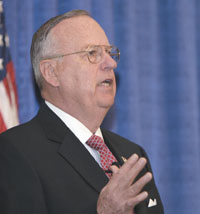 |
| Rear Adm. Thomas F. Hall, USN (Ret.), assistant secretary of defense for reserve affairs, gives the kickoff address at West 2006. |
“The concept of weekend warriors is dead,” Hall declared. “We are transitioning to a strategic and operational Reserve.”
Accordingly, the U.S. Defense Department is changing the way the Guard and the Reserve are treated. Instead of being mobilized for 18 months, the goal is to reduce that period to 12 months. The department also is trying to channel regular force benefits such as bonuses, health care and housing to Guard and Reserve personnel. For example, everyone who signs on for another stretch of duty in theater receives a $15,000 bonus.
Other challenges remain. It may take up to $25 billion to replace the equipment left in
However, Hall is heartened by the support being provided to Guard and Reserve personnel by
Hall took the opportunity to dash a couple of popular misconceptions. A total of 500,000 Guard and Reserve members have been called up since the September 11, 2001, attacks, but their presence is shrinking, not growing. A year ago, 185,000 Guard and Reserve members were on active duty, but now only 130,000—116,000 in the Army—are mobilized.
And, the Army, Guard and Reserve all recently exceeded their recruiting goals. More people are staying on active duty despite—or because of—the wartime deployment.
Saying that journalist Tom Brokaw was right in labeling the Depression/World War II generation “the greatest generation,” Hall declared, “Today we’re building the next-greatest generation.”
Immediately following Hall’s address was the show’s first panel discussion, which focused on warfighters’ lessons learned. Some panelists expanded on Hall’s comments, while others focused on new issues.
Moderating this panel was Lt. Gen. James N. Mattis, USMC, commanding general, Marine Corps Combat Development Command. Last year at West 2005, Gen. Mattis made remarks based on his combat experiences in
This year, few would argue with his point that the military must undergo significant changes to deal with the enemy in the global war on terrorism. War is a human problem, he stated, and the
Maj. Gen. Robert Scales,
As far as the Navy is concerned, the global war on terrorism is always running in the background—sometimes in the foreground, according to Rear Adm. Charles W. Martoglio, USN, director of the Navy’s Strategy and Policy Division (N5SP). Conventional campaigns are still out there, but the enemy is practicing unrestricted warfare—such as using children as human shields—that the
The U.S. military is not organized to fight this kind of war, declared Col. Gary L. Crowder, USAF, vice commander, 505th Command and Control Wing. Noting that the Defense Department budget is more than $400 billion and the State Department budget is about $25 billion, he urged that nonlethal resources be allocated to combat the influence of the enemy so that the country does not have to apply a military solution to every problem. “If all you have is a hammer, then everything looks like a nail,” he said.
But, when it comes to lessons learned, much of what the military has learned is basically what it knew before, stated Brig. Gen. Joe Dunford, USMC, director, Operations Division, Plans, Policy and Operations,
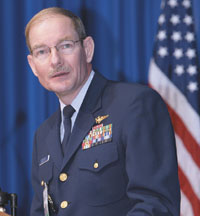 |
| Vice Adm. Harvey E. Johnson Jr., USCG, commander, Coast Guard Pacific Area Command, outlines the Coast Guard’s new missions and challenges. |
For example, the Pacific region has 73 million square miles that must be covered. The Coast Guard has the authority to deal with Pacific maritime threats, but they often extend beyond the Coast Guard’s reach. The Navy’s capabilities can help the Coast Guard’s national security mission, especially in protecting national economic zones.
The Coast Guard must balance homeland security with commerce. Domestically, 14 million shipping containers are handled annually in the
Adm. Johnson indicated that he is pleased with the relationship between the commander, U.S. Navy 3rd Fleet, and Coast Guard Pacific. This cooperation has been improving, and now both services can take steps to “rethink and redefine the relationship” between the Coast Guard and the Navy.
“The timing is right to ensure interoperability between [Coast Guard] Deepwater assets and Navy ships,” Adm. Johnson declared.
Intelligence is a key element for winning the war on terrorism, and its issues were the focal point of a panel moderated by Rear Adm. Tom Brooks, USN (Ret.), the former director of Naval Intelligence. He explained why intelligence operations today are much more difficult than they were in the Cold War. The enemy is “an elusive, ghost-like adversary,” he stated.
Capt. Paul Becker, USN, 5th Fleet intelligence officer, offered that his fleet’s intelligence is fundamentally sound, but it can improve. Kinetic attacks are fewer as Navy intelligence is helping deter terror attacks at sea. Effective coalition warfighting will require operationally relevant intelligence that can be shared at the appropriate levels, he added. Technologies that enable persistent surveillance are important, he emphasized.
The Marines have progressed significantly over the past few years, related Col. Francis X. Cubillo, USMC, commander, Marine Corps Intelligence Schools. Many of the Marine Corps intelligence problems that emerged in the 1991 Gulf War have been fixed, and the Corps has increased its number of intelligence personnel. It also received new equipment that it used for the first time in the Iraq War. But, the force needs to advance data sharing, he said.
One area of concern for the Navy—and the Pacific Fleet in particular—is
But now the threat is from terrorism, and Lt. Col. Ralph Peters,
In what proved to be prescient in light of the recommendations that emerged in the 2006 Quadrennial Defense Review a month later, the conference devoted significant time to special operations. The second day’s breakfast address was given by Vice Adm. Eric T. Olson, USN, deputy commander of the U.S. Special Operations Command (SOCOM). Adm. Olson both gave a history of
The global war on terrorism and the regime-changing operations in
The Iraq War brought increased deployment and effectiveness as special operations forces engaged in myriad dangerous operations before and during the onset of hostilities. These included minisubmarine missions in the northern part of the
The command has been speeding new technologies to its warfighters, but it still has several urgent needs. Efforts have lightened the radio and battery load that every person carries, but more remains to be done in that area. The command is deploying new network media that permit streaming video, and it continues to strive for new ways to exploit satellite communications. Adm. Olson cited the concept of MWR technologies—miniaturized, waterproofed and ruggedized—for special operations.
Despite the important role that technology plays in special operations, Adm. Olson maintained that the command’s personnel are its greatest asset. Currently, 7,000 SOCOM people are operating away from home. And, Adm. Olson related, in some cases they are where no other military forces have been.
“We must make sure we as a nation are developing an irregular war capability for the long haul,” the admiral declared. “Our weapon system is the human.”
Ironically, the U.S. Marine Corps was the last service to establish a special operations command, and it did so following a directive issued this past October. Adm. Olson stated that the Marine Corps will bring much-needed capabilities to SOCOM.
The commander of the Marine Corps Special Operations Command, Brig. Gen. Dennis J. Hejlik, USMC, was one of the panelists in a session that followed Adm. Olson’s address. Gen. Hejlik cut to the chase by describing the technologies that will be crucial to special operations forces.
Communications ranked high on his list because, like computers, their technology advances rapidly. Biometrics are a key technology for special operations forces that must keep track of foreign citizens to identify terrorists in their midst. Reconnaissance technologies to help find high-value targets, along with tools to aid the collaborative planning process, also are on the special operations forces’ wish list.
The panel’s moderator, Capt. Roger Crossland, USNR, a Navy SEAL, offered an interesting reflection. Noting that special operations forces teamed with Afghanistan’s Northern Alliance to drive the Taliban out of power in 2002, the captain offered that if the United States had sent in greater numbers of military personnel, the Northern Alliance might have viewed them as a threat on a par with the Soviets and instead teamed with the Taliban to defeat the U.S. military presence. Instead, the small number of special forces brought about the desired goal.
Capt. Sean A. Pybus, USN, commander, Naval Special Warfare Group One, warned that the increased reliance on special operations is straining Navy SEALs’ capabilities. The Navy does not have enough SEALs, he stated, as the service is barely staying even with mission demands. Nor can the Navy tap a wellspring to add more of these special forces. The Navy must field SEALs who are culturally attuned and linguistically capable in theater, the captain declared.
The panel’s final speaker, Col. Edward Reeder,
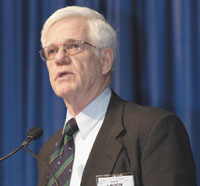 |
| Dr. Linton Wells II, deputy assistant secretary of defense for networks and information integration, discusses the Quadrennial Defense Review and the progress of network centricity. |
That review is “extraordinarily supportive” of network centricity, Wells told the audience. Network centricity is not just for operations, but also for business and intelligence in the defense arena. Operationally, the network must be extended to the tactical edge to create a robustly networked force that can share information for better situational awareness. The Global Information Grid (GIG) is a network as well as people and processes, he continued. It is a concept that is helping to bring network centricity together.
After describing the status of several major information system programs, Wells listed several challenge areas. One of these is mission assurance on the network. Wells stated that Defense Department information assurance must be better than the best commercial practices, and the Quadrennial Defense Review adds hundreds of millions of dollars to information assurance.
Other challenges include managing the GIG in wartime, managing spectrum and managing the development of risks in certain programs. He told industry, “We’re in this together,” and the Defense Department must leverage what is taking place in industry to advance defense information technology.
As Wells stepped off the stage, he was replaced by a panel that continued the focus on his major topics of discussion. Moderated by AFCEA International President and Chief Executive Officer Vice Adm. Herbert A. Browne, USN (Ret.), this luncheon panel explored how to get the right information technology to the warfighter.
“It is a Web services world,” stated David Wennergren, Navy chief information officer. He warned that legacy applications and networks are the most porous security threats in the system. Security may be the biggest reason to get rid of legacy systems, he suggested.
Wennergren also said that “the world of wireless is here” and the military should not be afraid of it. He also called for performance-based contracting and strong adoption of standards. The military, academia and the commercial world must come together to exploit commercial solutions and best practices.
“Driving out complexity is the best thing we can do for the warfighter,” declared Col. Robert Baker, USMC, technical director, Navy/Marine Corps Intranet. The colonel listed several new thrusts for that giant project, including development of a wireless pilot with layer II encryption, an embedded cellular card that allows laptops to access the commercial 2-megabit-per-second network for a fixed monthly rate and a broadband unclassified remote access service.
The problem with the Joint Tactical Radio System is that it has evolved from a legacy radio replacement program to a mobile ad hoc networking capability, according to Dennis Bauman, program executive officer, command, control, communications, computers, intelligence (C4I) and space, Space and Naval Warfare Systems Command (SPAWAR). The requirements scope is so large that it extends beyond the national budget, he stated.
Rear Adm. William D. Rodriguez, USN, acting commander, SPAWAR, explained how last year’s Trident Warrior exercise demonstrated coalition tools and networking along with human systems integration and information management. “It’s about the knowledge and it’s about the whole spectrum of solutions,” he said.
Attendees on the show’s final day heard from the unified commander responsible for the largest area of operations on the planet. Adm. William J. Fallon, USN, commander of the U.S. Pacific Command, split his Thursday luncheon address between an assessment of the global war on terrorism and the requirements of his command over the vast Asia-Pacific region.
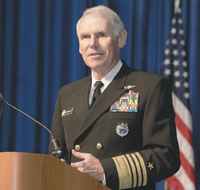 |
| Adm. William J. Fallon, USN, commander of the U.S. Pacific Command, describes the challenges from the war on terrorism faced by his vast command. |
For one thing, it is not specific to
However, the admiral emphasized that the
The Pacific Command is trying to help many Asian nations to build capabilities and the capacity to deal with terrorism and the conditions that feed it. However, many Southeast Asian countries distrust each other and have vulnerabilities such as nonsecure borders and rough economies. Growth with prosperity will not occur without security, Adm. Fallon declared.
On the battlefield, Adm. Fallon said that U.S. Central Command Commander Gen. John P. Abizaid,
Adm. Fallon called for persistent surveillance technologies to help fight terrorists. “We need to be able to look at areas that are suspect, wait these bad guys out, and then [deal with] them when they pop out,” he emphasized.
Turning information into something that forces can act on is a top priority, he continued. Again addressing industry, he said that there are many ways that his command could benefit from industry’s brainpower.
One show panel presented a star-studded lineup that included three vice admirals, a rear admiral, a major general and a retired admiral. Moderated by Adm. Leighton W. Smith, USN (Ret.), former commander, U.S. Naval Forces Europe, the panel featured type commanders suggesting measures that will lead the Navy well into the 21st century.
Rear Adm. Edward Masso, USN, vice commander, Surface Sea Warrior Enterprise, noted that the future Navy will include fewer sailors dealing with more diverse missions.
Vice Adm. James D. McArthur Jr., USN, commander, Naval Network Warfare Command, stated that command and control comprises elements such as sensors, networks and operational pictures that are presented to the commander for decision making. The Navy never will have the bandwidth that it needs, so commanders must develop doctrine and tactics, techniques and procedures for operating networks.
Vice Adm. Charles Munns, USN, commander, Submarine Force, U.S. Atlantic Fleet, and commander, Submarine Allied Command, Atlantic, described how the Navy is building the submarine of the future—the USS Virginia—today. However, the challenge is to build enough of them, with the current rate running two per year. To save money, the Navy installed a common commercial off-the-shelf auxiliary diesel engine instead of purchasing a government-supplied unit. The new diesel is based on a widely used model that is reliable and easy to use.
Maj. Gen. Samuel Helland, USMC, commanding general, 3rd Marine Aircraft Wing, asked industry attendees, “What are your innovations to help us fight IEDs [improvised explosive devices]?” He added that the military does not own the laboratories anymore, as they have migrated to the private sector. For the most part, information system solutions must fit everywhere across the full spectrum of joint and coalition operations.
And, Vice Adm. James M. Zortman, USN, commander, Naval Air Forces, and commander, Naval Air Force, U.S. Pacific Fleet, warned that keeping short-term fixes in place impedes long-term progress. This prevents full capabilities from emerging, he added.
While many of the discussions focused on technology, the human element in military supremacy was not overlooked. In a panel aptly titled “How Do We Do Right by Our People?” moderator Vice Adm. Albert H. Konetzni Jr., USN (Ret.), emphasized the importance of clear directives and concise standards for personnel. Good teams get underway on time and do not have drug problems or suicides, he stated.
The Navy will not have the “heel to toe” deployment cycle that it has now, declared Master Chief Petty Officer of the Navy Terry D. Scott, USN. The service must change as it is becoming smaller and smarter, and the country cannot be left with a legacy navy. While the Navy must be more flexible, it also must ensure that sailors have a good home life. Sailors must know that leaders believe that what they are doing is important, that leaders care about them, and that their families are all right at home while they are deployed overseas, the master chief petty officer stated.
The individual Marine is the Marine Corps’ most lethal weapon, according to Sgt. Major Raynard L. Watkins, USMC, Marine Corps Base Quantico. Today’s Marines are better trained than ever before, as even a 25-year-old corporal now can call for fire, which used to be available to officers only. As for the Marine Reserve, the sergeant major offered that there is no difference between an active duty Marine and a reserve Marine. It’s a “break glass” approach to being able to obtain and use a Marine reservist, he emphasized.
The Coast Guard’s mission has changed forever since the September 11 attacks, observed Master Chief Petty Officer of the Coast Guard Franklin A. Welch, USCG. When people ask when Coast Guard operations will return to normal, he answers that today is as normal as it ever will be through the rest of the century. To continue to carry out the missions that it accomplished in 2005, the Coast Guard must grow exponentially. Retention rates are good: 80 percent for enlisted personnel and 93 percent for officers. To ensure that these people can work smarter, “not work harder,” the Coast Guard has increased tuition assistance 300 percent, he added.
Photography by Michael Carpenter and Robert K. Ackerman.
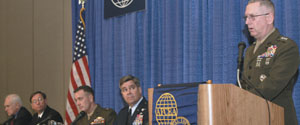 | Panelists discussing warfighters’ lessons learned from combat are (l-r) Maj. Gen. Robert Scales, USA (Ret.); Rear Adm. Charles W. Martoglio, USN; Brig. Gen. Joe Dunford, USMC; Col. Gary L. Crowder, USAF; and panel moderator Lt. Gen. James N. Mattis, USMC. |
 | Delivering intelligence to the warfighter is the topic of discussion among (l-r) panel moderator Rear Adm. Tom Brooks, USN (Ret.); Capt. Paul Becker, USN; Col. Francis X. Cubillo, USMC; Cmdr. Jim Fanell, USN; and Lt. Col. Ralph Peters, USA (Ret.). |
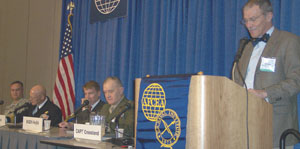 | Capt. Roger Crossland, USNR (r), introduces a panel on special operations forces and the support they need. Panelists are (l-r) Col. Edward Reeder, USA, commander, 7th Special Forces Group (Airborne); Capt. Sean A. Pybus, USN, commander, Naval Special Warfare Group One; Erik Prince, president and chief executive officer, Blackwater USA; and Brig. Gen. Dennis J. Hejlik, USMC, commander, Marine Corps Special Operations Command. |
 | Vice Adm. Herbert A. Browne, USN (Ret.), AFCEA International president and chief executive officer (r), moderates a luncheon panel on moving information technology to the warfighter. Panelists are (l-r) Rear Adm. William D. Rodriguez, USN, acting commander, Space and Naval Warfare Systems Command (SPAWAR); Dennis Bauman, program executive officer, command, control, communications, computers, intelligence and space, SPAWAR; Col. Robert Baker, USMC, technical director, Navy/Marine Corps Intranet; and David Wennergren, chief information officer, Department of the Navy. |
 | Personnel issues were the focus of a panel featuring (l-r) Master Chief Petty Officer of the Coast Guard Franklin A. Welch, USCG; Sgt. Major Raynard L. Watkins, USMC; Master Chief Petty Officer of the Navy Terry D. Scott, USN; and moderator Vice Adm. Albert H. Konetzni Jr., USN (Ret.). |
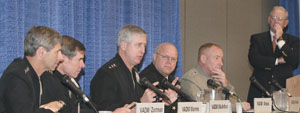 | Adm. Leighton W. Smith, USN (Ret.), former commander, U.S. Naval Forces Europe (r), listens as Vice Adm. James D. McArthur Jr., USN (c), commander, Naval Network Warfare Command, makes a point in a panel of type commanders discussing the way ahead. Panelists are (l-r) Vice Adm. James M. Zortman, USN, commander, Naval Air Forces, and commander, Naval Air Force, U.S. Pacific Fleet; Vice Adm. Charles Munns, USN, commander, Submarine Force, U.S. Atlantic Fleet, and commander, Submarine Allied Command, Atlantic; Adm. McArthur; Rear Adm. Edward Masso, USN, vice commander, Surface Sea Warrior Enterprise; and Maj. Gen. Samuel Helland, USMC, commanding general, 3rd Marine Aircraft Wing. |
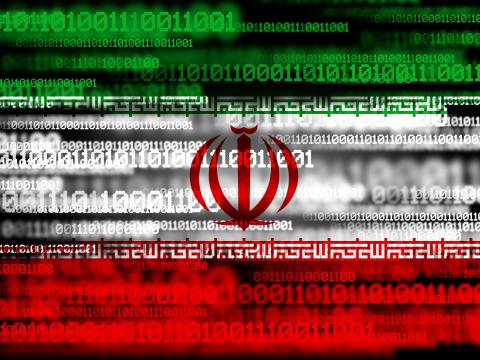
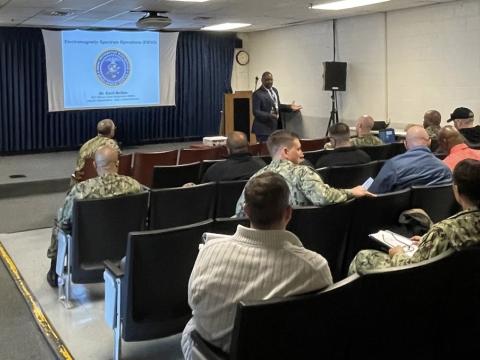


Comments